 |
| Category:
Colour patches |

|
|
|
|
|
AUSTRALIAN
MACHINE GUN CORPS  |
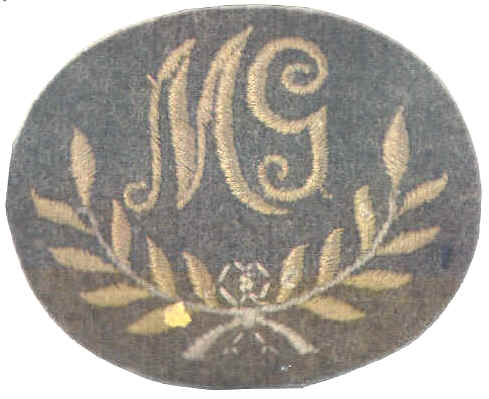 |
Created in
February 1916 by reorganising battalion machine gun sections into
machine gun companies allotted one per brigade.
HQ Aust. and NZ Forces CM No. 17,
25.2.1916, directed that machine gun companies then forming in Egypt
would wear the patch of the brigade HQ to which they belonged, with
the letters 'MG' in worsted on a circular piece of cloth beneath it.
The 9th, 10th, and 11th Machine Gun
Companies in the United Kingdom were directed to wear only their
brigade headquarters patch by 3rd Aust. Div. Instruction, para. 7, of
August 1916.
|
| British Machine gunner's
badge. It is possible, even probable, that Australian troops wore this
badge but I have no proof. Webmaster |
These
instructions were cancelled by AEFO No. 222 dated 23.8.1916 which
directed that each machine gun company would wear the patch of the
infantry brigade to which it was attached with the addition of crossed
guns in yellow worsted worn immediately below the patch. The crossed
guns were to be the patch of the Machine Gun Corps. It will be noted,
however, that machine gun squadrons allotted to Light Horse brigades
did not wear the "crossed guns". In April 1917 a further
five machine gun companies were raised and allotted as divisional
troops. Australian Imperial Force Order 594, dated 20th April 1917,
directed that each of these companies would wear the patch of the
headquarters of the division to which it was attached, with the patch
of the Machine Gun Corps worn directly below.
On 15 March 1918 the twenty companies of the Aust. Machine Gun Corps
were reorganised into five machine gun battalions. Although each
company retained its original designation, individual colour patches
were superseded by one patch for each battalion, approved by AEF Order
No. 1207, dated 26.4.1918. Note: this order was originally promulgated
in error as Australian Imperial Force Order 2007. Australian Imperial
Force Order 1214 of 3.5.1918 directed that it was to be renumbered as
Australian Imperial Force Order 1207.
|
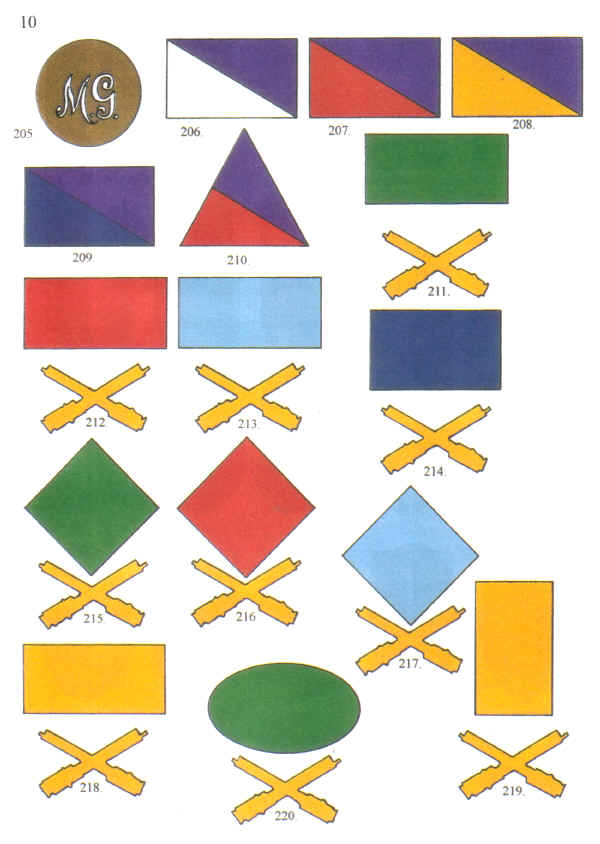 |
- 205. Aust. Machine Gun
Corps, 1916: To be worn below the
patch of the brigade headquarters to which the company was
attached vide HQ Aust. and NZ Forces CM No. 17. Correspondence
from the Director of the AWM states that in the case of the 8th,
14th, and 15th Aust. Machine Gun Companies the letters 'MG' were
embroidered directly onto the brigade headquarters colour patch,
for the 14th and 15th the letter 'G' being below the 'M'. Ref. AWM
93, item No. 12/3/11. The style of lettering depicted is not
confirmed as no example has yet been sighted.
- 206. 1st Aust. Machine
Gun Squadron, 1916 - 1919 : Auth.
Aust and NZ Mtd Div. RO
No. 1, para. 4, 18.10.1916.
- 207. 2nd Aust. Machine
Gun Squadron, 1916 - 1919: Auth.
Aust and NZ Mtd. Div. RO
No. 1, para. 4, 18.10.1916.
- 208. 3rd Aust. Machine
Gun Squadron, 1916 - 1919: Auth.
Aust and NZ Mtd. Div. RO
No. 1, para. 4, 18.10.1916.
- 209. 4th Aust. Machine
Gun Squadron, 1917 - 1919: Auth.
ATO 795, 10.8.1917.
- 210. 5th Aust. Light
Horse Brigade Machine Gun Squadron: Auth.
Australian Imperial Force Order 1521, 21.1.1919. The role of this
unit was undertaken by the 2nd Squadron, New Zealand Machine Gun
Corps, which been raised from No's 15 and 16 Companies, 4th
(Anzac) Camel Battalion on 1.7.1918. Although examples of this
patch are held in the Military Heraldry Collection AWM, there is
no reference in any New Zealand publication on that nation's
military insignia to suggest this colour patch was in fact worn.
- 211. 1st Aust. Machine
Gun Company, 1916 - 1918:
- 212. 2nd Aust. Machine
Gun Company, 1916 - 1918:
- 213. 3rd Aust. Machine
Gun Company, 1916 - 1918:
- 214. 4th Aust. Machine
Gun Company, 1916 - 1918:
- 215. 5th Aust. Machine
Gun Company, 1916 - 1918:
- 216. 6th Aust. Machine
Gun Company, 1916 - 1918:
- 217. 7th Aust. Machine
Gun Company, 1916 - 1918:
- 218. 8th Aust. Machine
Gun Company, 1916 - 1917:
- 219. 8th Aust. Machine
Gun Company, 1917 - 1918:
- 220. 9th Aust. Machine
Gun Company, 1916 - 1918:
|
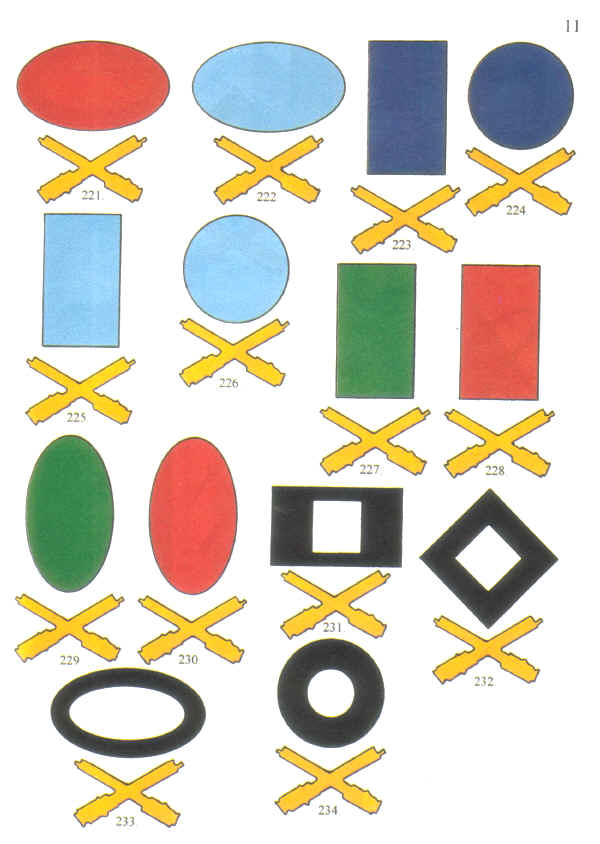 |
- 221. 10th Aust. Machine
Gun Company, 1916 - 1918:
- 222. 11th Aust. Machine
Gun Company, 1916 - 1918:
- 223. 12th Aust. Machine
Gun Company, 1916 - 1917:
- 224. 12th Aust. Machine
Gun Company, 1917 - 1918:
- 225. 13th Aust. Machine
Gun Company, 1916 - 1917:
- 226. 13th Aust. Machine
Gun Company, 1917 - 1918:
- 227. 14th Aust. Machine
Gun Company, 1916 - 1918:
- 228. 15th Aust. Machine
Gun Company, 1916 - 1918:
- 229. 16th Aust. Machine
Gun Company, 1917: Formed by
re-designation of the 3rd Aust. Divisional Machine Gun Company
between July and September 1917.
- 230. 17th Aust. Machine
Gun Company, 1917: Formed by
re-designation of the 4th Aust. Divisional Machine Gun Company
between July and September 1917.
- 231. 21st Aust. Machine
Gun Company, 1917 - 1918:
- 232. 22nd Aust. Machine
Gun Company, 1917 - 1918:
- 233. 3rd Aust.
Divisional Machine Gun Company,(see note 49) 1917;
and
- 23rd Aust. Machine Gun
Company, 1917 - 1918:
- 234. 4th Aust.
Divisional Machine Gun Company,(see note 50) 1917;
and
- 24th Aust. Machine
Gun Company, 1917 - 1918:
- Note 49. In addition to this unit, the
207th (British) Machine Gun Company served with the 3rd
Aust. Division between October 1916 and October 1917,
although there is no evidence it wore a colour patch. The
3rd Aust. Div. MG Coy joined the division in mid 1917, but
was allotted to 16th Aust. Infantry Brigade, 6th Aust.
Division, between July and September 1917.
- Note 50. Joined this division in. June
1917 but was almost immediately allotted to l7th Aust.
Infantry Brigade, 6th Aust. Division, not rejoining 4th
Aust. Division until September 1917.
|
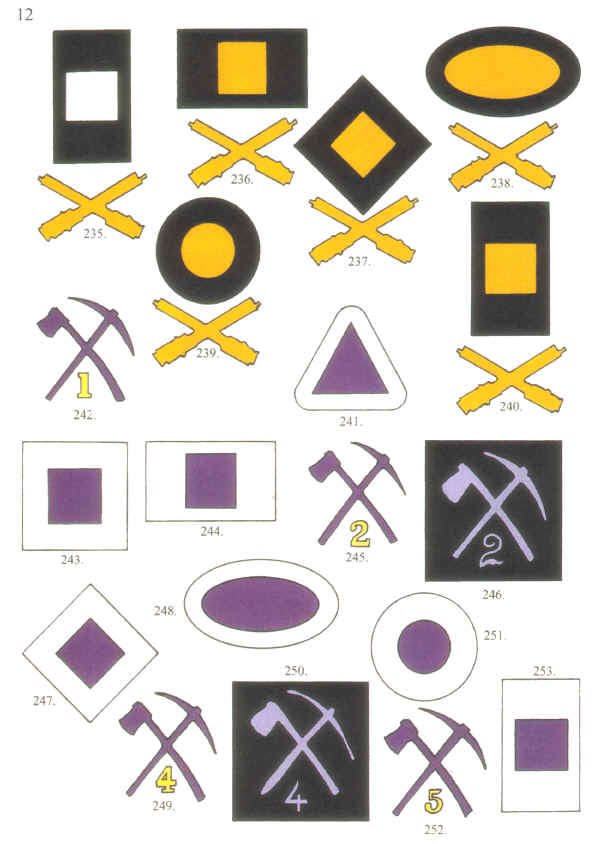 |
- 235. 5th Aust.
Divisional Machine Gun Company, 1917; and
- 25th Aust. Machine Gun
Company, 1917 - 1918:
- Did not join the division until September
1917.
- 236. 1st Aust. Machine
Gun Battalion, 1918 - 1919:
- Absorbed the 1st, 2nd, 3rd, and 21st Aust.
Machine Gun Companies.
- 237. 2nd Aust. Machine
Gun Battalion, 1918 - 1919 :
- Absorbed the 5th, 6th, 7th, and 22nd Aust.
Machine Gun Companies.
- 238. 3rd Aust. Machine
Gun Battalion, 1918 - 1919
- Absorbed the 9th, 10th, 11th, and 23rd Aust.
Machine Gun Companies.
- 239. 4th Aust. Machine
Gun Battalion, 1918 - 1919
- Absorbed the 4th, 12th, 13th, and 24th Aust.
Machine Gun Companies.
- 240. 5th Aust. Machine
Gun Battalion, 1918 - 1919
- Absorbed the 8th, 14th, 15th, and 25th Aust.
Machine Gun Companies.
- 241. 1st Aust. Armoured
Car Battery, 1917; and
- 1st Aust. Light Car
Patrol, 1917 - 1919: Auth.
Australian Imperial Force Order 613, 1.5.1917.
- This was actually the second design
approved for this unit. The first, which was unlikely to
have been issued, appeared in Anzac Mounted Division
Routine Orders dated 21.11.1916 and comprised a purple
circle, 2 inches in diameter, representing the colour
allotted to machine gun units in Egypt, superimposed on a
2 and 1/4 inch diameter white circle representing the
wheel of a motor vehicle. HQ AIF immediately directed that
this patch be redesigned as it was similar to that already
in use by the 4th Aust. Pioneer Battalion.
- 242. 1st Aust. Pioneer
Battalion, 1916 : Auth. HQ Aust.
& NZ Forces CM No. 17, 25.2.1916. Superseded by No. 243 in
April 1916.
- 243. 1st Aust. Pioneer
Battalion, 1916 - 1917: Auth. HQ
Aust. & NZ Forces CM No. 52, 20.4.1916. Stated to have been
superseded by No. 244.
- 244. 1st Aust. Pioneer
Battalion, 1917 - 1919 : Ref Vol.
III, The Official History of Australia in the War of 1914 - 1918.
No date can be located regarding the replacement of No. 243 by
this colour patch, the assumption being early 1917. First
Australian Division Standing Orders, 1917, para. 44 and Appendix
IV, makes no reference at all to any colour patch for 1st Aust.
Pioneer Battalion.
- 245. 2nd Aust. Pioneer
Battalion, 1916 : Auth. HQ Aust.
and NZ Forces CM No. 17, 25.2.1916.
- Superseded by No. 247 in April 1916.
- 246.2nd Aust. Pioneer
Battalion, 1916:
- Variation of No. 245 in chain stitch
embroidery.
- 247. 2nd Aust. Pioneer
Battalion, 1916 - 1919: Auth. HQ
Aust. and NZ Forces CM No. 52, 20.4.1916.
- 248. 3rd Aust. Pioneer
Battalion, 1916 - 1919: Auth.
Australian Imperial Force Order 231, 26.8.1916.
- 249. 4th Aust. Pioneer
Battalion, 1916 : Auth. HQ Aust.
and NZ Forces CM No. 17,
25.2.1916.
- Superseded by No. 251 in April 1916.
- 250. 4th Aust. Pioneer
Battalion, 1916 :
- Variation of No. 249 in chain stitch
embroidery.
- 251. 4th Aust. Pioneer
Battalion, 1916 - 1919 : Auth. HQ
Aust. and NZ Forces CM No. 52, 20.4.1916.
- 252. 5th Aust. Pioneer
Battalion, 1916 : Auth. HQ Aust.
and NZ Forces CM No. 17, 25.2.1916. Superseded by No. 253 in April
1916.
- This colour patch was not issued, HQ 5th
Aust. Division being advised in April 1916 that stocks were
available for initial issue to all units of the division with
the exception of the pioneer battalion.
- 253. 5th Aust. Pioneer
Battalion, 1916 - 1919 ~ Auth. HQ
Aust. and NZ Forces CM No. 52, 20.4.1916.
|
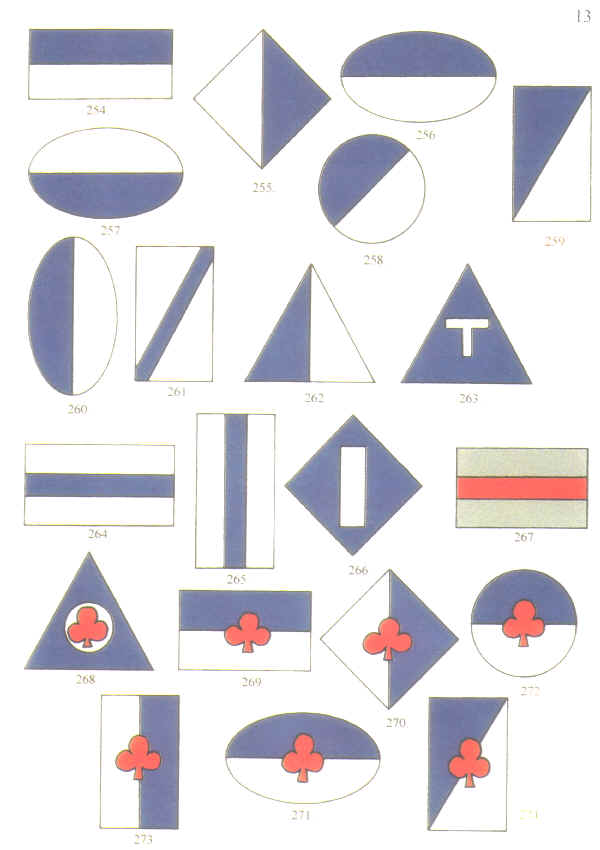 |
- 254. 1st Aust. Division
Train, 1915 - 1919: Auth. I Aust.
Div. Order No. 562, 8.3.1915. 1st, 2nd, 3rd, and 4th Coys AASC
(741st, 742nd, 743rd and 744th Coys ASC), 1st Fd Bky, 1st Fd Bchy,
1st to 5th DUS. Initially also comprised No. 10 Company (1st Aust.
Reserve Park) AASC.
- 255. 2nd Aust. Division
Train, 1915 - 1919 : Auth. 2
Aust. Div. Instruction, 3.8.1915. 15th, 16th, 17th, and 20th Coys
AASC (745th, 746th, 747th, 748th Coys ASC, 2nd Fd Bky, 2nd Fd
Bchy, 6th to 10th DUS.
- 256. 3rd Aust. Division
Train, 1916 - 1919 : Auth. 3
Aust. Div. Instr, August 1916. 22nd, 23rd, 24th, and 25th Coys
AASC (867th, 868th, 869th, 870th Coys ASC, 3rd Fd Bky, 3rd Fd
Bchy, 11th to 15th DUS.
- 257. 3rd Aust. Division
Train : Auth. Australian Imperial
Force Order 231, 26.8.1916. Although shown as a cancelled patch by
Vol. 111, 'Official History of Australia in the War of 1914 -
1918',the description of this patch contained in the above order
is an error, and was corrected by an amendment promulgated in
Australian Imperial Force Order 340/1916, 21.10.1916.
- 258. 4th Aust. Division
Train, 1916 - 1919: Auth. HQ
Aust. and NZ Forces CM No. 17, 25.2.1916. 7th, l4th, 26th, and
27th Coys AASC (753rd, 754th, 755th and 756th Coys ASC), 4th Fd
Bky, 4th Fd Bchy, l6th to 20th DUS.
- 259. 5th Aust. Division
Train, 1916 - 1919: Auth. HQ
Aust. and NZ Forces CM No. 17, 25.2.1916. 10th, l8th, 28th, and
29th Coys AASC (757th, 758th, 759th and 760th Coys ASC, 5th Fd
Bky, 5th I'd Bchy, 21st to 25th DUS.
- 260. 6th Aust. Division
Train, 1917 : Auth. AAG AIF
Letter No. 15/42, 25.5.1917. Only the 30th and 3 1st Companies
AASC were raised for this formation, and were disbanded in
September 1917.
- Note: The 11th, 13th, 19th, and 21st
Companies AASC were disbanded in early 1916 to form the field
bakeries and butcheries, and depot units of supply, for the
1st and 2nd Aust. Divisions. The original 4th ALH Brigade
Train (14th Company AASC and 4th ALH Brigade Ammunition
Reserve) was disbanded in July 1915 and absorbed by 2nd Aust.
Division Train.
- 261. (a) AASC, Aust. and
NZ Mounted Division, 1916 - 1917: Auth.
Aust. and NZ Mtd. Div. RO No. 1, para. 4, 18.10.1916. The original
light horse brigade trains (5th, 6th, and 12th Companies, AASC,
and the 1st, 2nd, and 3rd ALH Brigade Ammunition Reserves) were
disbanded in mid 1916, with only a brigade supply element
remaining with each Aust. Light Horse Brigade until September
1917.
- (b) Australian and
New Zealand Mounted Division Train, 1917. 32nd,
33rd, and 34th Companies AASC, 26th DUS. - 1919 :
- (c) Australian
Mounted Division Train, 1917 - 1919 : 35th,
36th, 37th, and 38th Companies AASC, 27th DUS.
Note: Approval to raise the mounted division trains
was given in September 1917 by Australian Imperial Force Order
877/1917. No. 5 Company NZASC which formed part of the Anzac Mounted
Division did not wear this patch. In October 1917 a patch of identical
design, but with colours reversed and measuring 2 inches by 3/4 inch,
was approved for wear horizontally on both sides of the hat puggaree
by this unit. Ref. Thomas and Lord, New Zealand Army Distinguishing
Patches, 1911-1991, Part One, p.28.
- 262. 1st Aust. Railhead
Supply Detachment, 1918 - 1919 : Auth.
Australian Imperial Force Order 1306, 19.7.1918. Formerly part of
No. 11 Company AASC, later 1st Anzac Railway Supply Detachment
then 1st Anzac Railhead Supply Detachment.
- 263. Aust. Sea Transport
Service, 1916 - 1919 : Auth.
Australian Imperial Force Order 396, 9.12.1916. Worn by permanent
staff on sea transports.
- 264. No. 1 Aust. Remount
Unit, 1916: and
- Australian Remount Unit,
1916 - 1917:
- 265. No. 2 Aust. Remount
Unit, 1916:
- Note: No's 264 and 265 initially appeared in
"Distinguishing Marks and Badges AIF", undated but
submitted for drafting on 14.3.1916. A photograph facing page
147 of "Hooves, Wheels and Tracks ", dated February
1916, shows No. 264 in use at that point. No. 264 is again
depicted as the Australian Remount Unit in line drawings
notified by AIF Admin. HQ Memo No. 26144 of 31.10.1916, No.
265 apparently no longer being in use at that stage. Both
units were raised in September 1915, arriving in Egypt in
December 1915. They were reorganized in March 1916 as the
Australian Remount Unit, comprising four squadrons, which was
further reduced in September 1916 to a remount depot,
comprising a headquarters and two squadrons. This patch was
superseded by No. 266 in May 1917.
- 266. Australian Remount
Unit, 1917 - 1919 : Auth.
Australian Imperial Force Order 613, 1.5.1917. Note: Personnel
with service in remount units in Egypt during the Gallipoli
campaign were forbidden to wear the brass 'A' under the terms of
MO 20/1918 because they were specifically enlisted in a
non-combatant role. Ref. AA(Vic.): MP 742/1, item 87/1/37.
Note: The colour patch system approved for
divisional and corps motor transport units AASC between 1916 and 1918.
(Refers specifically to No's 268 to 285, and 293 to 296B.) The designs
of patches allotted to ammunition parks and sub-parks, and supply
columns, of the AIF from May 1916 were based on vehicle markings
approved by the War Office in December 1915 for these types of units.
The red shell standing on its base was for vehicles of divisional
ammunition sub-parks, while the red shell with blue band and red
zigzag used unofficially as a colour patch by siege battery ammunition
columns in 1918 was originally approved (without the red zigzag) for
vehicles of the ammunition columns of RGA brigades, and battery
ammunition vehicles of tractor drawn gun or howitzer batteries. An
identical shell shaped mark, vertically halved red and blue, was later
approved for vehicles of army field artillery brigade park sections.
The trefoil, referred to also as the ace of clubs, was symbolic of
supply, and was approved, in red for vehicles of divisional supply
columns. Lettering and numerals for No's 276-285 and 293-295 were to
be of blue cloth, 1/2 inch high, bars to be 1/2 inch wide and 1/8 inch
thick, although these dimensions vary. Trefoils were 3/4 inch high.
- 267. Australian Motor
Transport Service, 1916 - 1919: Ref.
'Distinguishing Marks and Badges AIF", undated, and AIF
Admin. HQ Memo No. 26144, dated 31.10.1916. The former reference
shows this patch as not yet allotted. It may have been worn by
personnel of the 1st, 2nd, and 3rd Aust. Auxiliary Motor Transport
Companies prior to disbandment in July 1917, and there is evidence
from a contemporary diary held by the RAMS of WA that it was worn
by the siege battery ammunition columns in 1918. The auxiliary
motor transport companies were disbanded to provide personnel for
the formation of the 2nd and 5th Aust. Divisional Supply Columns
and the 5th Aust. Divisional Ammunition Sub-Park.
- 268. Headquarters, 'K'
Corps Supply Column, 1917 - 1918: Auth.
Australian Imperial Force Order 859,18.9.17.
- 269. No. 1 Aust.
Divisional Supply Column, 1916 - 1918 : Auth.
Australian Imperial Force Order 340, 21.10.1916. Raised as No. 9
Company AASC, serving subsequently under British command as No.
300 (Aust.) Company ASC, then 17th Divisional Supply Column, until
returning to the 1st Aust. Division in early 1916. This unit is
credited with introducing the divisional sign of the 17th
Division, a square 'dot' and rectangular 'dash' in black on a
white oblong background, the dot and dash representing the Morse
letter 'A'.
- from Divisional and Other Signs, V.
Wheeler-Holohan, p. 50. This was initially a vehicle marking.
- 270. No. 2 Aust.
Divisional Supply Column, 1917 - 1918: Auth.
Australian Imperial Force Order 859,18.9.1917.
- 271. No. 3 Aust.
Divisional Supply Column, 1916 - 1918 : Auth.
Australian Imperial Force Order 340, 21.10.1916. Also numbered as
No. 808 (Aust.) Company ASC.
- 272. No. 4 Aust.
Divisional Supply Column, 1917 - 1918: Auth.
Australian Imperial Force Order 911, 16.10.1917.
- 273. No. 5 Aust.
Divisional Supply Column, 1917 - 1918: Auth.
Australian Imperial Force Order 859,18.9.1917.
- 274. No. 5 Aust.
Divisional Supply Column :
- Example held in a private collection. It has
been worn, and is most likely to have been worn by an
individual, not on a unit basis.
|
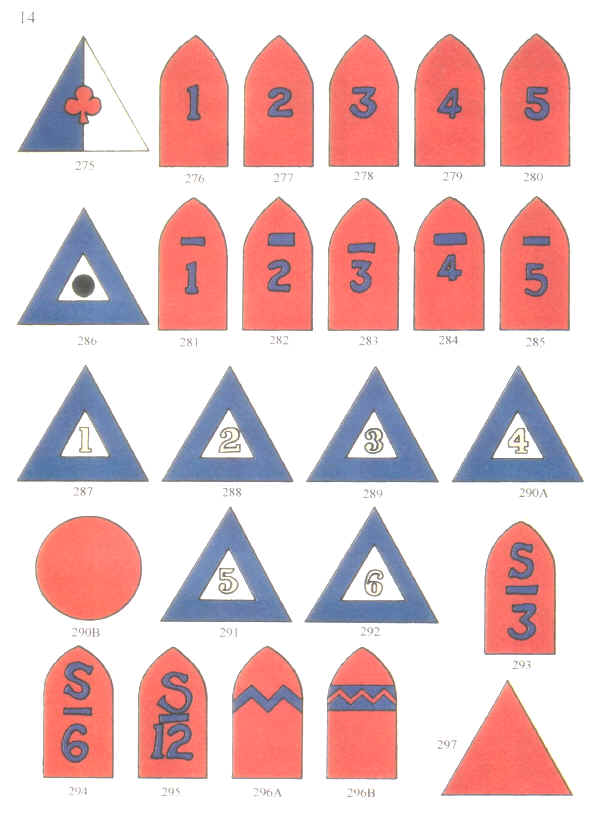 |
- 275. 1 ANZAC Corps
Troops Supply Column, 1916 - 1918; and
- Aust. Corps Troops
Supply Column, 1918: Auth.
Australian Imperial Force Order 340, 21.10.1916.
- 276. 1 ANZAC Corps
Ammunition Park, 1916 - 1917; and
- HQ 'K' Corps
Ammunition Park, 1917 - 1918:
Auth. Australian Imperial Force Order 143, 11.5.1916.
- 277. II ANZAC Corps
Ammunition Park, 1916 - 1917;
- HQ 'Y' Corps
Ammunition Park, 1917 - 1918 : Auth.
Australian Imperial Force Order 143, 11.5.1916. For AIF
personnel only, but this patch was not cancelled by Australian
Imperial Force Order 1216 of 3.5.1918, and may not even have
been in use by this stage as the unit was predominantly
British.
- 278. Unidentified: Military Heraldry Collection,
AWM.
- 279. Unidentified: Military Heraldry Collection,
AWM.
- 280. Unidentified: Military Heraldry Collection,
AWM.
- Note: It is possible that No's 278 to 280
inclusive were supplied in error for the 3rd, 4th and 5th
Aust. Divisional Ammunition Sub-Parks following their
reorganization as part of the Corps Ammunition Parks in
January 1917. Large stocks of these examples were handed over
to the AWM at the end of the Great War.
- 281. 1st Aust.
Divisional Ammunition Sub-Park, 1916 - 1918 : Auth.
Australian Imperial Force Order 143, 11.5.1916.
- Formerly No. 8 Company AASC, then
redesignated No. 301 (Aust.) Company ASC, and finally 17th
Divisional Ammunition Sub-Park, serving under British command
until the 1st Aust. Division arrived in France in March 1916.
- 282. 2nd Aust.
Divisional Ammunition Sub-Park, 1916 - 1918 : Auth.
Australian Imperial Force Order 143, 11.5.1916.
- Raised in early 1916 as 23rd Divisional
Ammunition Sub-Park from 4 personnel of the 17th Divisional
Ammunition Sub-Park and Supply Column, serving under British
command until the 2nd Aust. Division arrived in France in
March 1916.
- 283. 3rd Aust.
Divisional Ammunition Sub-Park, 1916 - 1918 Auth.
Australian Imperial Force Order 143, 11.5.1916.
- 284. 4th Aust.
Divisional Ammunition Sub-Park, 1916 - 1918 Auth.
Australian Imperial Force Order 143, 11.5.1916.
- 285. 5th Aust.
Divisional Ammunition Sub-Park, 1917 - 1918 Auth.
Australian Imperial Force Order 143, 11.5.1916.
In March 1918, Aust. Corps Motor Transport was
re-organised to form a headquarters (absorbed HQ 'K' Supply Column and
HQ 'K' Ammunition Park) and six motor transport companies, formed from
the supply column and ammunition sub-park allotted to each of the five
divisions. 'Me corps troops supply column formed the sixth company.
Authority for the colour patches allotted to these seven units (Nos.
286 to 292) was Australian Imperial Force Order 1216, dated 5.3.1918.
Numerals were approved in 1/2 inch high brass, although bullion wire
examples also exist.
- 286. HQ Aust. Corps
Motor Transport Column, 1918 - 1919:
- 287. 1st Aust. Motor
Transport Company, 1918 - 1919:
- 288. 2nd Aust. Motor
Transport Company, 1918 - 1919 :From
2nd Aust. Divisional Supply Column and 4th Aust. Divisional
Ammunition Sub-Park.
- 289. 3rd Aust. Motor
Transport Company, 1918 - 1919:
- 290A. 4th Aust. Motor
Transport Company, 1918 - 1919 : From
4th Aust. Divisional Supply Column and 2nd Aust. Divisional
Ammunition Sub-Park.
- 290B. 4th Aust. Motor
Transport Company, 1919: Auth. SO
AASC(MT) Memo No. 303, 7.6.1919.
- To be worn I inch below their original unit
colour patch by personnel posted to this unit.
- 291. 5th Aust. Motor
Transport Company, 1918 - 1919:
- 292. 6th Aust. Motor
Transport Company, 1918 - 1919:
- 293. 3rd Aust. (Army)
Field Artillery Brigade Park Section, 1917 - 1919 : Auth.
AIFO 859,18.9.1917.
- 294. 6th Aust. (Army)
Field Artillery Brigade Park Section, 1917 - 1919 : Auth.
Australian Imperial Force Order 859,18.9.1917.
- 295. 12th Aust. (Army)
Field Artillery Brigade Park Section, 1917 - 1919: Auth.
Australian Imperial Force Order 859,18.9.1917.
- 296A. Siege Battery
Ammunition Columns, 1919 :
- Example, Military Heraldry Collection AWM. No
authority for this patch has been located although its use has
been acknowledged in correspondence between the Director of
the AWM and the staff of the Official Historian (AWM 93, item
12/3/11). The 1st and 2nd Aust. Siege Battery Ammunition
Columns were raised in March 1918 from personnel rendered
surplus by the reorganization of the Aust. Corps motor
transport units.
- 296B. Siege Battery
Ammunition Columns:
- An example of this colour patch appears in
the Victoria Barracks Collection, although it is believed to
be of post war manufacture. It is also depicted on several
privately published colour charts printed after the Great War
and a contemporary sketch exists in AWM 25, item No. 89/8,
with a note that it was introduced after the Armistice.
- 297. Staff Officer,
A.A.S.C. (Motor Transport), 1919: Auth.
SO AASC(MT) Memo, 7.6.1919.
- To be worn I inch below their original unit
colour patch by personnel posted to the establishment of this
headquarters. This staff controlled the 4th Aust. Motor
Transport Company AASC and the AIF Graves Detachment which
continued to operate in France and Belgium after
demobilisation of the AIF had commenced.
|
|
The
material on this section of the site is drawn from "Distinguishing
Colour Patches of the Australian Military Forces 1915-1951" by
Keith Glyde. ISBN 0-6460-36640-8 |
|